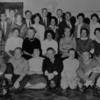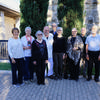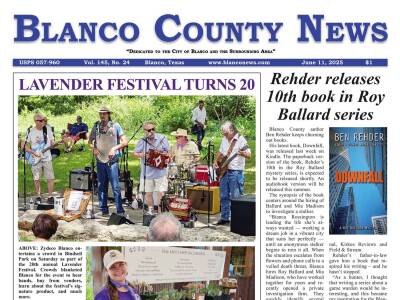

Blanco was the chosen venue of a group of Peace Corps volunteers (PCVs) who have reunited in various locations in North and South America over the past five decades.
Local resident Barney Cline convinced the group, many of who had never been to Texas, to give Blanco the honors for their reunion. A dozen PCVs and their spouses traveled to Blanco last week.
Cline, who served in Bolivia at that time as a Peace Corps Physician (U.S. Public Health Service officer), a staff member responsible for keeping them healthy.
“During the very early days of the Peace Corps, in 1963 they were among the first group of PCVs in Bolivia, one of the poorest nations in the Americas, then with an illiteracy rate of more than 90 percent,” Cline said. “They were young, idealistic and highly motivated Americans who wanted to serve. I was in Bolivia at that time as a Peace Corps Physician (U.S. Public Health Service officer), a staff member responsible for keeping them healthy.
“Through the years I have kept in contact with one special member of this group, Rose Navarro (originally from Chicago but now living in Colorado),” he said, “a remarkable lady, a registered nurse and the spark-plug of this group.”
The group of 12 former PCVs stayed at the Blanco Settlement and enjoyed area attractions, including a trip to the River Walk in San Antonio and live music at the Settlement.
Corps, the concept for the Corps followed up on an idea launched at the University of Michigan, where then-presidential candidate Sen. John F. Kennedy, addressed 10,000 students at the university and issued a challenge: How many of them, he asked, would be willing to serve their country and the cause of peace by living and working in the development world.
President Kennedy signed an executive order establishing the Peace Corps on March 1, 1961. Three days later, R. Sargent Shriver became its first Director. Deployment was rapid: Volunteers began serving in five countries in 1961. In just under six years, Director Shriver developed programs in 55 countries with more than 14,500 Volunteers.
Since 1961, more than 220,000 Americans have responded to this enduring challenge.
Navarro and her colleagues were one of the first to volunteer, and were selected to be part of “Bolivia 1,” the first PCVs sent to Bolivia.
“In Bolivia she performed heroically, working at a hospital in a remote area during an outbreak of a deadly viral disease, Bolivian Hemorrhagic Fever, during which many residents of San Joaquin died before researchers determined the cause of the disease, and determined how to stop the epidemic,” Cline said.
Navarro remembers her experience vividly.
“I think I always wanted to go overseas,” she said. “In high school, I must have mentioned it several times. I went to nursing training. And after graduation, I stopped at my old high school and ran into one of the sisters, who asked me if I had followed my dream to travel.”
She realized that’s what she wanted to do.
“After looking into the Dr. Doolittle and Papal Volunteer mission programs, I learned about the Peace Corps,” Navarro said. “I was there 2.5 years. I stayed on a few more months to finish the project.”
“For a young person it was an exciting adventure,” she said. “It was exciting for all of us. You’ll hear different stories from each of us. For the men, there was more variety. They were able to move around more. Engineers got to go all over the country. One of our group, Bob Fergerstrom, was abducted during an uprising in mountains and was taken as a hostage.”
Fergerstrom and his wife made the trip to Blanco to join the group some 55 years later. He and several other engineers were with “Bolivia 1” along with nurses, dental hygienists and food educators.
“After we learned we had been accepted, 63 of us met in Norman, Okla., where we did our first training,” Navarro said. “By the time we left there were only 33 left. You’re in this group of folks from all over the country with all different political views. I grew up in south Chicago in a Mexican neighborhood, a catholic neighborhood. It was very different for me to be around people from different parts of the country and with differing points of view.”
From Norman, the group went to Puerto Rico where they underwent physical training. Navarro noted that the Peace Corps has since done away with the physical training requirement.
“Once we arrived in Bolivia, we each had an assignment,” she said. “When we first arrived in 1962, I was sent to Trinidad in Bolivia. One of our physicians was called to help, and I got permission to go there with him.”
“This was the first group to go to Bolivia, and here are a lot of politics,” she said. “It took a while to work things out. When we got there in July, by Dec only three remained there and the rest of us were sent elsewhere. Jerry and Lois stayed in the area helping to set up a hospital at a leper colony. Kathy Larks worked in La Paz. Wherever you were sent, you had to make your own way.”
“In Bolivia Rose performed heroically, working at a hospital in a remote area during an outbreak of a deadly viral disease, Bolivian Hemorrhagic Fever, during which many residents of San Joaquin died before researchers determined the cause of the disease, and determined how to stop the epidemic,” Cline said. “This is but one example of the unique experiences of these folks.
Navarro worked with a group of Americans arrived from Panama who stayed on project for several years afterward.
“Scientists came in from all over – Montana, England,” she said. “A lot of Brazilian medical staff were there to figure out what was going on with this mysterious fever. I remember one of the patients was autopsied in a very primitive manner. I remember a room lit by a single light bulb hanging from the ceiling. There were flies. A child was being autopsied with many people around the table trying to see. From the specimen taken from was were virus was discovered. I remember his name was Oscar.”
“Everyone wherever they were assigned, the Peace Corps Volunteers had adventures,” Navarro said. “Not everything was rosy. There were many times when things were slow. But you realize that’s how life is. We were working there, but we could walk away after two years. This is their life.”
Navarro and Cline kept in touch after an expedition they shared, which he wrote about in a book he published recent.
“Since he was writing this book, that’s how we started communicating,” she said. “So I could help with some of the details and memories for his book.”




